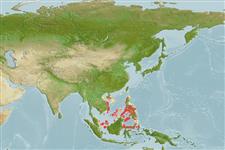>
Blenniiformes (Blennies) >
Tripterygiidae (Triplefin blennies) > Tripterygiinae
Etymology: Helcogramma: Greek, helkos, -eos, -ous = ulcer, sore + Greek, gramma = letter, mark (Ref. 45335); desa: The specific epithet is derived from the Latin "desa", meaning neglected. The name refers to the fact that this species has been overlooked in previous studies of the group. The name is treated as Noun in apposition.
Environment: milieu / climate zone / depth range / distribution range
Ecologia
marinhas bentopelágico; intervalo de profundidade 0 - 7 m (Ref. 52308). Tropical
Western Pacific: Philippines and Viet Nam.
Tamanho / Peso / Idade
Maturity: Lm ? range ? - ? cm
Max length : 5.5 cm TL macho/indeterminado; (Ref. 90102)
Descrição breve
Chaves de identificação | Morfologia | Morfometria
Espinhos dorsais (total) : 17 - 18; Raios dorsais moles (total) : 11 - 13; Espinhos anais: 1; Raios anais moles: 20 - 21. A species of Helcogramma (sensu Hansen, 1986) with 2 symphisial mandibular sensory pores, second dorsal fin spines XIV (three specimens with XV), third dorsal fin segmented rays 10-11, last ribs on vertebral centrum 10-11, vertebrae modally 10+28=38, pored lateral line scales modally 22 or 23, nape scales present, males with dusky anal fin.
Adults are found at depths of 7 m and shallower, in surge channels and exposed coasts of rocky boulders (Ref. 90102). Eggs are hemispherical and covered with numerous sticky threads that anchor them in the algae on the nesting sites (Ref. 240). Larvae are planktonic which occur primarily in shallow, nearshore waters (Ref. 94114).
Life cycle and mating behavior
Maturidade | Reprodução | Desova | Ovos | Fecundidade | Larvas
Williams, J.T. and J.C. Howe, 2003. Seven new species of the triplefin fish genus Helcogramma (Tripterygiidae) from the Indo-Pacific. aqua, J. Ichthyol. Aquat. Biol. 7(4):151-176. (Ref. 52308)
Categoria na Lista Vermelha da IUCN (Ref. 130435: Version 2024-2)
Ameaça para o homem
Harmless
Utilização humana
Ferramentas
Relatórios especiais
Descarregue XML
Fontes da internet
Estimates based on models
Preferred temperature (Ref.
123201): 27.6 - 29.2, mean 28.8 °C (based on 346 cells).
Phylogenetic diversity index (Ref.
82804): PD
50 = 0.5000 [Uniqueness, from 0.5 = low to 2.0 = high].
Bayesian length-weight: a=0.00617 (0.00288 - 0.01322), b=3.04 (2.86 - 3.22), in cm total length, based on LWR estimates for this (Sub)family-body shape (Ref.
93245).
Nível Trófico (Ref.
69278): 3.1 ±0.3 se; based on size and trophs of closest relatives
Resiliência (Ref.
120179): Elevada, tempo mínimo de duplicação da população menor que 15 meses (Preliminary K or Fecundity.).
Fishing Vulnerability (Ref.
59153): Low vulnerability (10 of 100).
